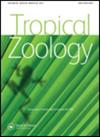巴拿马恢复健康的霍夫曼二趾树懒的放生后生态
IF 0.7
4区 生物学
Q4 ZOOLOGY
引用次数: 0
摘要
随着人类的扩张和拉丁美洲森林砍伐率的提高,野生动物救援和恢复领域继续发展。Sloths(Bradypus spp.和Choloepus spp.)由于其扩散能力差和易受人为影响,经常被拉丁美洲各地的救援中心接纳。尽管放生后的监测是衡量野生动物救援计划成功与否的基础,但很少有研究评估将人工饲养的树懒放归野外的结果。2019年至2020年,我们研究了巴拿马中部修复和迁移的霍夫曼二趾树懒(Choloepus hoffmanni)的生态学。从野外救出的11只二趾树懒被人工饲养727±193天,然后进行无线电标记,放置在室外500平方米的软释放围栏中3个月,然后在附近的国家公园释放。在软释放围栏中,二趾树懒80.0%的时间都在休息,晚上变得更活跃、更警觉(p=0.01)。释放到野外后,两趾树懒在连续辐射定位之间的平均线性距离为82.3±21.6米,平均距离为25.6±9.5米。平均家庭范围大小为2.92±1.19公顷,女性占据的面积比男性大。二趾树懒使用dbh小于可用dbh的树木(p≤0.001;p≤0.015),并选择树冠密集且藤本含量≥50%的树木。记录了8起死亡事件,捕食和自然原因是死亡的主要原因。月存活率为0.72±0.14,雄性(1.00±0.00)和雌性(0.44±0.22)之间没有差异(p≤0.30)。康复后的二趾树懒表现出与野生二趾树獭相似的行为和空间使用模式,只是在野外放生后存活率较低。我们的研究提供了有助于评估整个拉丁美洲树懒救援和康复计划效果的信息。本文章由计算机程序翻译,如有差异,请以英文原文为准。
Post-release ecology of rehabilitated Hoffmann’s two-toed sloths in Panamá
The field of wildlife rescue and rehabilitation continues to grow as human expansion increases the rate of deforestation in Latin America. Sloths (Bradypus spp. and Choloepus spp.) are often admitted to rescue centers throughout Latin America due to their poor dispersal abilities and vulnerability to anthropogenic impacts. Although post-release monitoring is fundamental to measuring the success of wildlife rescue programs, few studies have assessed the outcomes of releasing hand-reared sloths back into the wild. We studied the ecology of rehabilitated and relocated Hoffmann’s two-toed sloths (Choloepus hoffmanni) in central Panamá during 2019- 2020. Eleven two-toed sloths rescued from the wild were hand-reared in captivity for 727±193 days and then radiomarked, placed in an outdoor 500 m2 soft-release enclosure for 3 months, and released in a nearby national park. While in the softrelease enclosure, two-toed sloths spent 80.0% of their time resting and became active and more alert in the evening (p=0.01). Upon release into the wild, two-toed sloths traveled a mean linear distance of 82.3±21.6 m and a mean distance of 25.6±9.5 m between successive radiolocations. The mean home range size was 2.92±1.19 ha, with females occupying larger areas than males. Two-toed sloths used trees with a smaller dbh than available (p≤0.001; p≤0.015) and selected trees with dense crowns and ≥50% lianas. Eight mortalities were recorded, with predation and natural causes being the main causes of mortality. Monthly survival was 0.72±0.14 and did not differ (p≤0.30) between males (1.00±0.00) and females (0.44±0.22). Rehabilitated two-toed sloths exhibited behavioral and space use patterns similar to wild two-toed sloths, with the exception of having lower survival rates following release in the wild. Our study provides information that can be useful in evaluating the efficacy of sloth rescue and rehabilitation programs throughout Latin America.
求助全文
通过发布文献求助,成功后即可免费获取论文全文。
去求助
来源期刊

Tropical Zoology
生物-动物学
CiteScore
2.50
自引率
0.00%
发文量
1
审稿时长
>12 weeks
期刊介绍:
Tropical Zoology is an international zoological journal publishing original papers in the field of systematics, biogeography, phylogeny, ecology and conservation of all terrestrial and aquatic animal Phyla from tropical and subtropical areas.
Only papers with new information, high quality and broad interest are considered. Single species description and checklists are not normally accepted. Review papers are welcome. The journal is owned by the Istituto di Ricerca sugli Ecosistemi Terrestri of the Consiglio Nazionale delle Ricerche, Florence, Italy (CNR-IRET) who performs research into the structure and functioning of aquatic and terrestrial ecosystems, focusing in particular on anthropogenic pressure and global change. The knowledge amassed forms the scientific basis for identifying the most appropriate protective and corrective interventions, and provides support for the bodies entrusted with formulating policies for environmental protection and recovery.
 求助内容:
求助内容: 应助结果提醒方式:
应助结果提醒方式:


